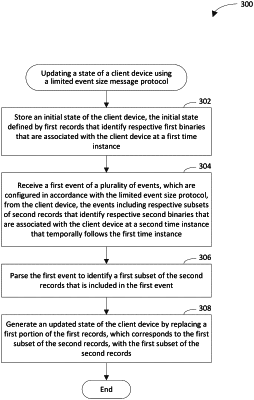| CPC G06F 9/542 (2013.01) [G06F 16/23 (2019.01)] | 20 Claims |

|
1. A computing system comprising:
a processing system; and
a memory that stores computer-executable instructions that are executable by the processing system to at least:
store an initial state of a client device, which is coupled to the computing system, in the memory,
the initial state defined by a first plurality of records that identify a first plurality of respective binaries that are associated with the client device at a first time instance;
receive a plurality of events from the client device at a plurality of respective time instances,
the plurality of events including respective subsets of a second plurality of records,
the second plurality of records identifying a second plurality of respective binaries that are associated with the client device at a second time instance that temporally follows the first time instance; and
based at least on receipt of each of the plurality of events, perform the following:
parse the respective event to identify the respective subset of the second plurality of records that is included in the respective event; and
trigger a respective incremental update of a state of the client device without regard to whether another event of the plurality of events has been received from the client device by replacing a respective portion of the first plurality of records, which corresponds to the respective subset of the second plurality of records, with the respective subset of the second plurality of records.
|